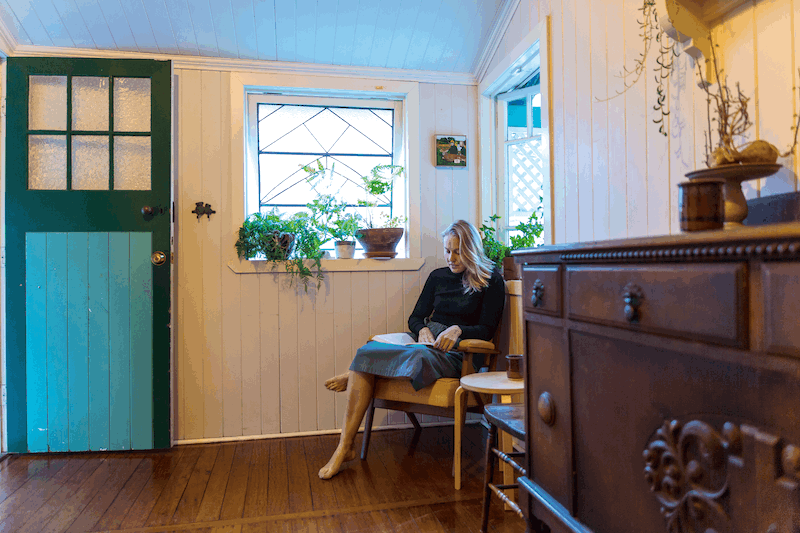Elizabeth Willing: Good Taste
Elizabeth Willing’s practice has a distinct materiality that engages all the senses. Her work pushes the limits of everything edible, from foraging and food anxiety to marshmallows and marzipan.
Words: Jo Higgins
Photography: Damien O’Mara
There’s a wonderful (some may even say delicious…) irony to Elizabeth Willing’s interest in the many meanings of taste – and her thoughtful, witty and rather empathetic exploration of them within the context of the reinstated Melbourne Art Fair.
Willing has been working at the intersections of art and design – “a constant preoccupation of my practice” – since completing her Bachelor of Fine Art from Queensland University Technology in 2008. Traversing sculpture, installation, performance and participatory social events, Willing’s practice has a distinct materiality that engages all the senses. In past works, she has tested the limits of materials including toffee, marshmallows and marzipan, using nostalgia, humour and a sense of the familiar to examine the social and cultural shifts that accompany rituals of cooking, eating, procuring and presenting food. Recently, she has begun to explore ideas of sustainability, food anxiety, foraging, native plants and the ways that food cultures develop.
Willing’s exhibition with Tolarno Galleries at MAF is a series of independent, multi-sensory works designed to “cross-pollinate”, says the artist. They come together as the singular installation, Strawberry Thief, which is also the title of Willing’s William Morris-inspired wallpaper. The wallpaper, which “physically and conceptually frames all the other objects”, is accompanied by a series of collages, abstract sculptures and participatory performances.
The wallpaper re-imagines Morris’s iconic 17th-century design, replacing the pattern of British fauna and flora with native Australian plants. For Willing, “the use of native Australian foods both complements and contrasts the English heritage of the original. A substantial portion of what we understand as Australian food culture comes from English roots, but this paper adopts content from a much older local culture.” In placing these Indigenous plants within an English framework, Willing comments not only on the current fashion of using native ingredients, but the irony of international gastronomic trends leading us back to flavours of Australia that were here long before the English arrived.
Dark (2017–18) is her series of giclée print collages, the latest in a series that Willing began more than six years ago, extracting nostalgic images from found 1970s cookbooks. These particular works take as their inspiration “the absurdity of the fruitcake tradition, a steaming dense Christmas pudding on a hot December day”, says Willing. “And its laborious cooking process, amplified through the obsessive process and forms of these collages.”
Willing’s two sculptural forms, Untitled (2018) have been made from recycled Australian hardwoods and preserved with the traces of their past lives: knots and nail holes and borer marks. Into them, Willing has carved “enormous, absurd” shortbread moulds, “continuing the discussion [in Strawberry Thief] around the dominant roots of Australian food culture: the introduced, the environment for which we have made the introduced adapt. I am quite aggressively carving the introduced food traditions (shortbread) into the native Australian timbers, which act as host to these impressions.” The upright standing sculpture doubles as a minimalist, domestic drinking bar, around which Willing’s series of hour-long performances will take place over the course of the Fair.
The cocktail recipe used in her work Anxiolytic (2018) has been created in collaboration with Melbourne mixologist Cennon Hansen and takes Willing’s homemade valerian tincture, replete with designed bottles and labelling, as its central, soothing ingredient. Continuing her interest in foraging cultures, Anxiolytic also addresses Willing’s concerns with anxiety, self-medication and the current conversations around mental health and creativity.
Says Willing: “If the viewer partakes in the cocktail performance, they will be engaging with taste, touch, and olfactory senses, as well as a level of intoxication, which will influence their experience of the rest of the installation.” They will also drink from Pacify (2018), a series of specially designed, tapered, etched glass cups made from altered beakers, with all their associations of alchemy and illegal drug production. Willing has pierced each glass with a tiny hole, through which the liquid gently weeps. “The drinker is encouraged to stem the flow with their finger, to comfort, soothe, pacify the cup in its state of loss,” says the artist. “In the act of blocking the tiny hole, the drinker is more aware of their body; the delicate choreography of their hands, and the act of drinking that is normally so trivial. We also have a direct connection of the cocktail with our fingertip and our mouth, creating a full circle of pacification.”
This will be Willing’s first time showing at the Melbourne Art Fair, but her work has been exhibited both internationally and at home since 2008. Now with a Masters of Fine Art from QUT, recent major solo exhibitions include Shades of Yellow at the Künstlerhaus Bethanien in Berlin in 2015, which was part of her 2014–15 Australia Council Berlin residency, and Impossible Guest at New England Regional Art Museum in Armidale in 2018, also the product of a 2017 residency.
Willing has undertaken mentorships with Janine Antoni in New York, Thomas Rentmeister in Berlin and the Experimental Food Society in London. Recent special projects include We Who Eat Together at Brisbane’s Gallery of Modern Art restaurant in 2016, in collaboration with GOMA executive chef Josue Lopez. The seven-course degustation performance was conceived in response to the GOMA exhibition Sugar Spin: You Me, Art and Everything. In addition to the Australia Council Berlin residency, Willing has also been the recipient of several Australia Council grants, the 2013 NAVA Freedman Foundation Travelling Scholarship and the 2015 Helsinki International Art Programme Residency.
This article was originally published in Art Collector issue 85, JUL–SEPT 2018.













